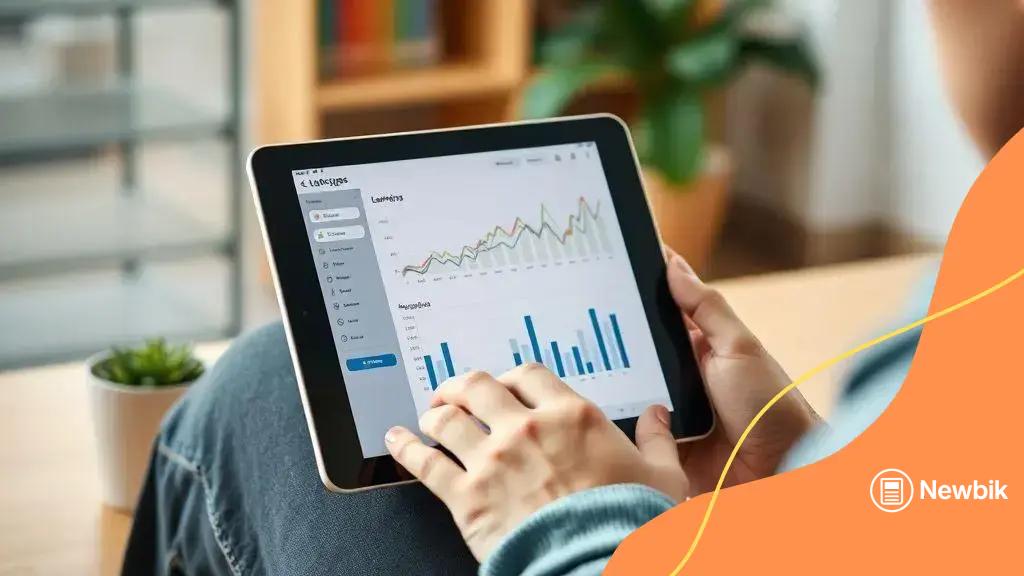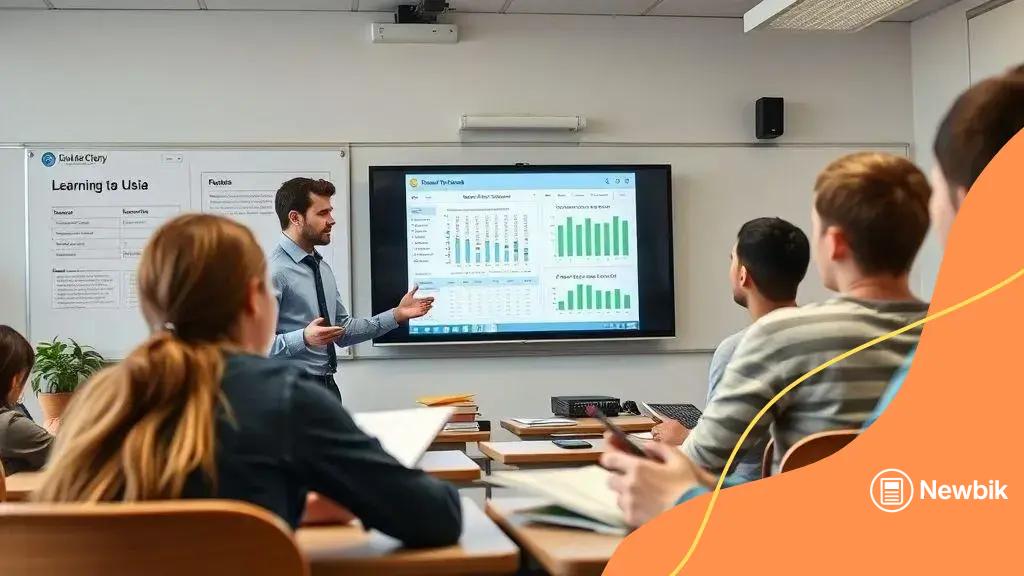eLearning tracking tool: enhance your learning experience

eLearning tracking tools are essential for enhancing educational outcomes by providing insights into student progress, enabling personalized learning experiences, and integrating advanced technologies like AI and gamification.
eLearning tracking tool technology has transformed how we engage with educational content. Whether you’re a student or a trainer, these tools offer insights that can help maximize learning experiences. Curious how they work? Let’s dive in!
Understanding eLearning tracking tools
Understanding eLearning tracking tools can elevate your educational experience. These tools are designed to monitor progress and measure the effectiveness of online learning.
There are various aspects of these tools that are essential for educators and learners alike. Let’s break down some key features that can enhance learning outcomes.
Key Features of eLearning Tracking Tools
These tools offer functionalities that help in tracking and analyzing learning activities. Some of the most notable features include:
- Progress Tracking: Monitoring how much content users have completed.
- Assessment Analytics: Evaluating quiz results to identify areas needing improvement.
- User Engagement Metrics: Understanding how often and how long users are interacting with the content.
- Reporting Capabilities: Generating reports that provide insights on learning trends and outcomes.
By utilizing these features, educators can tailor their instruction to better meet the needs of their students. For instance, if a learner struggles with particular topics, educators can provide additional resources or support.
The effectiveness of eLearning tracking tools not only benefits learners but also assists instructors in refining their teaching strategies. It creates a feedback loop that fosters communication and understanding.
Importance of Tracking
Tracking learning progress can empower both learners and educators. When learners see their progress, it motivates them to engage more with the material. Educators can make informed decisions based on the data provided by these tools, improving overall learning experiences.
Implementing eLearning tracking tools in educational settings creates a structured environment where both parties can thrive. As technology continues to advance, these tools will evolve, providing even greater benefits.
Key features to look for
When selecting eLearning tracking tools, it’s important to know which features will best meet your needs. These tools can vary greatly in functionality, and understanding the key features to look for can help you make an informed choice.
Essential Features to Consider
Among the most crucial features are those that enhance usability and provide valuable insights. Here are some essential features you should prioritize:
- Customizable Dashboards: A dashboard that allows users to tailor their view helps in prioritizing information that matters most.
- Real-time Analytics: Access to data as it happens ensures that both educators and learners can make timely decisions.
- Integration Capabilities: The ability to integrate with other platforms makes the tracking tool more versatile and user-friendly.
- Mobile Accessibility: Learning on-the-go is essential, so ensure the tool can be accessed easily via mobile devices.
Having these features can significantly impact how effective the tool is. For instance, real-time analytics allows educators to see how learners are performing instantly. This enables timely interventions to help struggling students.
In addition to these features, user-friendliness cannot be overlooked. A complex interface might deter users from fully utilizing the tool. Thus, prioritize tools that provide clear navigation and easy access to data.
Additional Considerations
Another aspect worth considering is the support and resources provided by the tool’s vendor. Adequate training resources and customer support can make a significant difference in the overall experience.
Also, consider scalability. As your educational needs grow, the eLearning tracking tool should be able to adapt and expand accordingly. This flexibility ensures that it remains a valuable asset in your learning ecosystem.
How eLearning tracking can improve outcomes

eLearning tracking plays a critical role in improving educational outcomes. By monitoring learning progress, instructors can identify challenges and support learners more effectively. As such, understanding how these tools work can lead to better results.
Targeted Feedback
With the right tracking tools, educators can provide targeted feedback that addresses specific learning gaps. When learners receive personalized insights on their performance, they are more likely to stay engaged and motivated.
- Identify Knowledge Gaps: Tracking assessments helps pinpoint areas where students struggle.
- Enhance Motivation: Feedback encourages students to improve and achieve their goals.
- Improve Retention Rates: Knowing where to focus can lead to better understanding and retention of material.
In turn, this level of engagement fosters a positive learning experience. For instance, a student aware of their strengths and weaknesses is more likely to take initiative in their studies. Thus, utilizing tracking tools can create a cycle of increasing self-awareness and academic success.
Data-Driven Decisions
Another significant advantage of eLearning tracking is enabling data-driven decisions. Educators can analyze trends across different courses and modify their teaching methods accordingly. By utilizing aggregate data, they can improve course content that resonates more with learners.
This approach not only aids in enhancing course quality but also promotes continuous improvement. Instructors who adapt based on insights gathered from tracking tools can create a richer educational environment. Analyzing student engagement and retention data may lead to implementing new teaching strategies that cater to diverse learning styles.
Ultimately, incorporating eLearning tracking serves as a valuable enhancement to the educational process. It empowers both learners and instructors, ensuring everyone can achieve their fullest potential.
Integrating eLearning tracking with existing systems
Integrating eLearning tracking tools with existing systems can greatly enhance educational experiences. By connecting innovative tracking solutions with established learning management systems (LMS), schools and organizations can create a cohesive learning environment.
Benefits of Integration
When eLearning tracking tools seamlessly integrate with existing systems, it leads to numerous benefits, such as:
- Streamlined Data Flow: Automatic data transfer reduces manual work and errors.
- Comprehensive Analytics: Combined data from various sources creates a complete view of learner progress.
- Enhanced User Experience: Users can navigate through connected platforms without any disruption.
Streamlined data flow means educators can access real-time information without having to switch between different platforms. This not only saves time but also ensures that decisions are based on the most current data.
Steps for Successful Integration
Successfully integrating these tools requires careful planning. Consider the following steps to ensure smooth integration:
- Assess Compatibility: Check if the eLearning tracking tool can work with current systems.
- Plan for Data Migration: Create a strategy for transferring existing data into the new system.
- Provide Training: Ensure staff are trained on how to use integrated systems effectively.
By assessing compatibility first, organizations can avoid potential technical issues that might arise during integration. A well-planned data migration will help maintain data integrity and continuity in learning processes.
Furthermore, providing training equips staff with the skills needed to navigate and utilize the integrated systems effectively. This ensures that everyone is on the same page and can make the most of the new technology.
Ultimately, integrating eLearning tracking tools with existing systems creates a more robust learning framework. This synergy enhances both teaching and learning experiences, allowing for continuous improvement.
Future trends in eLearning tracking
Understanding the future trends in eLearning tracking helps educators and institutions prepare for upcoming changes. As technology evolves, tracking tools will adapt to better serve educational needs.
Increased Personalization
One significant trend is the move towards enhanced personalization in learning experiences. As eLearning tracking tools gather more data, they can provide tailored content that meets individual learner needs. This customization improves engagement and retention.
- Adaptive Learning Paths: Systems that adjust content based on student performance.
- Customized Feedback: Specific insights for each learner based on their unique progress.
- User-Centric Design: Interfaces that cater to diverse learning styles.
The use of adaptive learning paths allows students to progress at their own pace. This means that if someone struggles with a topic, the system can offer additional resources to help them succeed.
Integration of Artificial Intelligence
Another trend gaining momentum is the integration of artificial intelligence (AI) in eLearning tracking. AI can analyze vast amounts of data quickly and efficiently, providing insightful analytics that human instructors might overlook.
AI-driven analytics can help identify trends in student behavior. For example, if many students find a particular concept challenging, educators can address these gaps proactively. Moreover, AI can automate routine tasks, giving educators more time to focus on teaching.
As eLearning tracking becomes more sophisticated, we may also see improvements in special education. AI can help tailor educational content for students with unique learning challenges, ensuring everyone receives the support they need.
Gamification in Learning
Additionally, gamification is expected to play a larger role in eLearning tracking. By incorporating game-like elements into the learning process, educators can boost motivation and engagement.
- Leaderboards: Encouraging competition among learners to achieve high standings.
- Your Progress: Visual indicators of progress can motivate students.
- Rewards and Badges: Recognizing achievements as students complete tasks.
These elements tap into natural human instincts for achievement and competition. When students feel a sense of accomplishment, they are more likely to stay engaged with the content.
Looking ahead, the landscape of eLearning tracking will likely become more innovative and user-friendly. As trends evolve, both educators and learners will benefit from enhanced resources and strategies that promote effective teaching and learning.
FAQ – Frequently Asked Questions about eLearning Tracking Tools
What are eLearning tracking tools used for?
eLearning tracking tools are used to monitor student progress, assess learning outcomes, and provide insights that help educators improve teaching strategies.
How can AI improve eLearning tracking?
AI can analyze large data sets quickly, providing valuable insights into student behavior and performance, allowing for more informed and timely adjustments in teaching.
What benefits does gamification provide in eLearning?
Gamification increases student engagement and motivation by incorporating game-like elements such as points, badges, and leaderboards into the learning process.
Why is personalization important in eLearning?
Personalization allows content to be tailored to individual learners’ needs, enhancing their learning experience and improving retention rates.